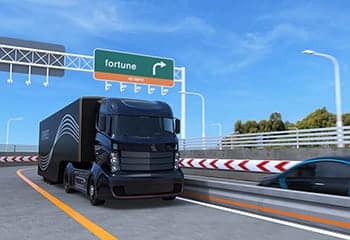Transportation Trends – A Glimpse into 2017
With new innovations, regulations, and shifts in the economy, carriers are constantly adapting in response to changes in the industry. Here are some trends to anticipate rolling into 2017.

With new innovations, regulations, and shifts in the economy, carriers are constantly adapting in response to changes in the industry. Here are some trends to anticipate rolling into 2017.

Though Phase 2 of National Highway Traffic Safety Administration (NHTSA) and EPA truck emissions regulations aren’t scheduled until 2018, carriers are already preparing for the cost. World class emissions controls, devices capable of eliminating as much as 98 percent of particulate matter, will be installed in 2017 models. While the electronics drive innovation and protect the air, they’ve also shown to be costly—$1,090 for the trailers-only rule in 2018 and $12,300 per-vehicle tractor by 2027.
As mentioned in our high-tech safety measures article, 2017 anticipates a number of longer-term technology improvements that will benefit on-road safety. Among these advancements is the influx of automated vehicles. Otto, a subsidiary of Uber Technologies Inc., completed the first delivery by a self-driving truck earlier this year. With cameras, radar, and lidar sensors guiding the way, companies are able to save money through reduced fuel and more frequent schedules. Autonomous trucking has the potential to increase overall efficiency in the transportation industry.
A court appeal to overturn the Federal Motor Carrier Safety Administration’s (FMCSA) electronic logging device (ELD) mandate was recently denied. The federal mandate requires ELDs to strengthen driver compliance with hours-of-service regulations. The devices monitor driving time, engine hours, vehicle movement, miles driven, and location. Set to take effect in late 2017, the mandate is expected to reduce capacity while positively influencing supply and demand for the industry.
State-specific regulations may also present a problem for drivers. Regulations in California and other states have already begun governing meal breaks and overtime pay. A surcharge of 2 percent on shipments moving in and out of California has also been instituted, leaving truckers uncertain of what legislations are next.
The FTR (Freight Transportation Research) Trucking Conditions Index’s (TCI) recognizes a positive trend for 2017, reflecting capacity tightening caused by additional regulations. At a reading of 5.47 for September, this anticipated drag on capacity is expected to improve pricing and margins for carriers, forecasted to reach its peak late 2017/early 2018.
Sign up to stay current with Bennett and Transportation Industry news. We send out a digital newsletter monthly. Unsubscribe any time.